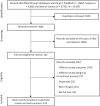Clinical predictors of severe dengue: a systematic review and meta-analysis
- PMID: 34627388
- PMCID: PMC8501593
- DOI: 10.1186/s40249-021-00908-2
Clinical predictors of severe dengue: a systematic review and meta-analysis
Abstract
Background: Severe dengue is a life-threatening complication; rapid identification of these cases, followed by adequate management is crucial to improve the clinical prognosis. Therefore, this study aimed to identify risk factors and predictors of severe dengue.
Methods: A literature search for studies reporting risk factors of severe dengue among individuals with dengue virus infection was conducted in PubMed, Scopus and Web of Science database from inception to December 31, 2020. Pooled odds ratios (ORs) for patients' demographic characteristics, co-morbidities, and warning signs were estimated using an inverse variance heterogeneity model.
Results: We included 143 articles in the meta-analysis from a total of 13 090 articles retrieved from the literature search. The risk factors of severe dengue were: being a child [OR = 1.96; 95% confidence interval (CI): 1.22-3.13], secondary infection (OR = 3.23; 95% CI: 2.28-4.57), and patients with pre-existing diabetes (OR = 2.88; 95% CI: 1.72-4.81) and renal disease (OR = 4.54; 95% CI: 1.55-13.31). Warning signs strongly associated with severe disease were increased haematocrit with a concurrent decrease in platelet count (OR = 5.13; 95% CI: 1.61-16.34), abdominal pain (OR = 2.00; 95% CI: 1.49-2.68), lethargy (OR = 2.73; 95% CI: 1.05-7.10), vomiting (OR = 1.80; 95% CI: 1.43-2.26), hepatomegaly (OR = 5.92; 95% CI: 3.29-10.66), ascites (OR = 6.30; 95% CI: 3.75-10.60), pleural effusion (OR = 5.72; 95% CI: 3.24-10.10) and melena (OR = 4.05; 95% CI: 1.64-10.00).
Conclusions: Our meta-analysis identified children, secondary infection, diabetes and renal disease(s) as important predictors of severe dengue. Our finding also supports the predictive ability of the WHO warning signs to identify severe dengue. These findings are useful for clinicians to identify severe dengue for management and timely interventions.
Keywords: Meta-analysis; Risk factor; Severe dengue; Warning sign.
© 2021. The Author(s).
Conflict of interest statement
The authors declare that they have no competing interest.
References
-
- World Health Organization: Dengue and severe dengue. https://www.who.int/news-room/fact-sheets/detail/dengue-and-severe-dengue. Accessed July 07 2021.
-
- World Health Organization. Dengue haemorrhagic fever: diagnosis, treatment, prevention and control. 2nd edition. Geneva 1997.
Publication types
MeSH terms
LinkOut - more resources
Full Text Sources
Medical


